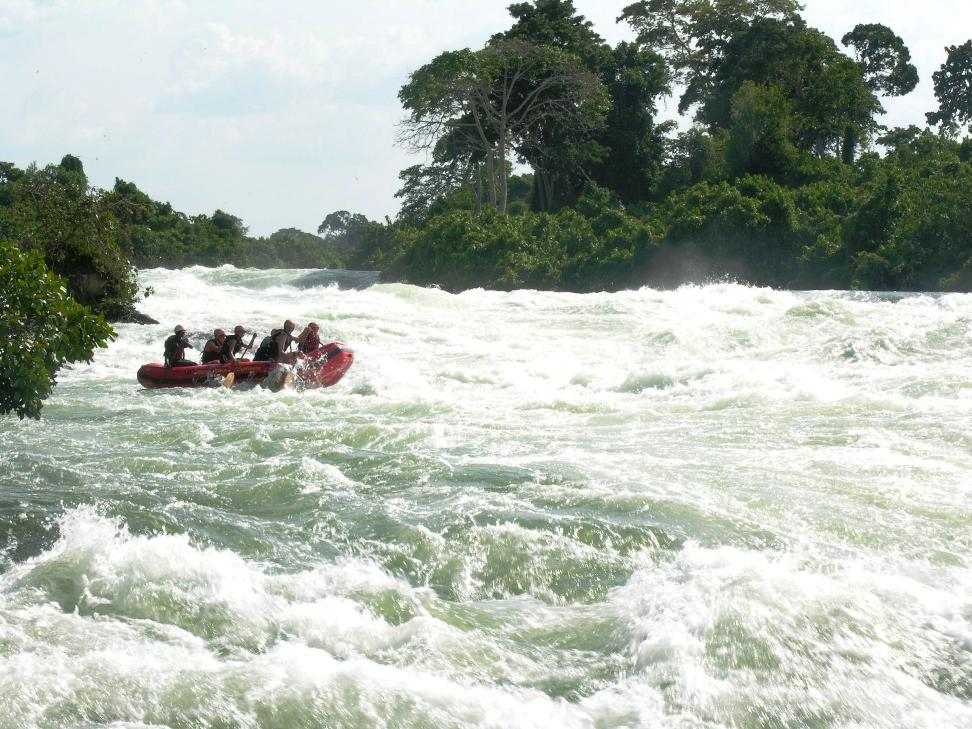The highlight of the past week had to be an all-day whitewater rafting trip I took down the Nile River. We started at the source of the Nile and went 30 km downstream, through several class 3-5 rapids. We managed to flipped the raft once, and I fell overboard three times. It was a blast. Here is what it looked like.
Then I spent a few days in the town of Jinja, right on the river. There is a nice park by the river so I spent one evening there snapping these photos.
A fisherman.
A bird poking around for a meal.
A couple more different shots of boats on the river.
I liked the colors of this boat.
Some photos of the town. This woman is inspecting day-old chicks for sale.
There was a stretch where several people sat with sewing machines on the sidewalk. Who needs a shop?
On the road to Kampala. Harvesting tea leaves.
I stayed a few days in Kampala trying not to get hit by a car or motorcycle. The traffic there is unbelievable. Here is a shot from my hotel window.
There’s no welfare system in Uganda so you see many poor people begging on the streets, many of them with horribly deformed limbs. One young woman had elephantitis or something; one leg was swollen the size of a tree trunk. I could not bring myself to take a photo. However, I saw this little boy just sitting on the sidewalk with his arms out. Normally I don’t give money to kids but I gave him a few cents for the photo.
Ugandans are proud of the educational system, which they claim produces more educated people than surrounding countries. I’m not so sure about that, but there are dozens of booksellers like this one on the sidewalk so I guess they do read a lot.
Some people think God is the answer. this guy was shouting from the Bible at passing cars and pedestrians. Two other common sights in Kampala: soldiers and scooters.
A Bloody Start
The first 25 years of Uganda’s independence were about as bad as it gets. Why did so many African countries get stuck with some of the worst humans to ever populate the earth? After gaining independence in 1962 Uganda was ruled by Milton Obote, who immediately banned all political parties and nationalized foreign assets while discriminating against other tribes. His chief of staff was Idi Amin, who overthrew Obote in a coup in 1971. The next eight years must have been hell for Uganda. Amin was probably one of the worst heads of state ever. The army was empowered to shoot on sight anyone suspected of opposition to the regime. During Amin’s reign an estimated 300,000 Ugandans lost their lives, often in horrific ways: bludgeoned to death with sledgehammers and iron bars, or tortured to death in prisons and police stations. In Kampala, the screams of those who were being tortured or beaten to death could often be heard around the clock for days on end. Prime targets of Amin’s death squads were the Acholi and Lango tribes, the tribes of Obote and his supporters. As in much of Africa, fighting took place along tribal lines. The tribes were decimated. Whole villages were massacred.
Next, Amin went after the professional classes; university professors, doctors, cabinet ministers, lawyers and business people. Anyone who may have posed a threat was dragged off and never seen again.
Also targeted was the Asian community. In 1972 the 70,000 Asians were given 90 days to leave the country. Most of them ran small shops and businesses. These were grabbed by Amin’s cronies and the wealth squandered as the businesses were so poorly managed.
Eventually the economy collapsed, industrial activity ground to a halt, hospitals and rural health clinics closed, roads became riddled with potholes, cities became garbage dumps and utilities fell apart. The prolific wildlife was machine-gunned by soldiers for meat, ivory and skins. It was a disaster.
Finally in 1979 Amin was forced out by the Tanzanian army, after he decided to attack them to draw attention away from his ruined country. The Tanzanians then helped themselves to whatever was left before going home, paving the way for Obote’s return to power and further atrocities. Eventually the current president, Museveni, took over and has been in charge for the past 20 years or so. People complain about him too, but as I told one person, “he’s a hell of lot better than what you had before.”
There have been far worse dictators in history, of course. Three hundred thousand dead is only one tenth those killed by Pol Pot and the Khmer Rouge in Cambodia, and it’s a drop in the bucket compared to Hitler, Stalin and Genghis Khan.
So give ol’ Dada a break: as far as brutal sadistic murdering dictators go, he wasn’t all that bad.
